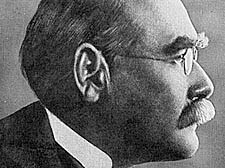|
|
 |
| |

Rudyard Kipling

A scene from the Walt Disney version of Jungle Book, perhaps
Kipling’s most famous work |
A tale of two Kiplings
Rudyard Kipling is one of our
most enduring writers, but also a mass of contradictions, finds
Piers Plowright
Kipling by Jad Adams,
Haus Publishing Company, £18
IF I’d been looking out of my window in the Spring of 1935
I might have seen a small man, top-hatted and probably dress-ed
in black, on the arm of an even smaller, thick-set woman, going
through the wrought-iron gates of Burgh House Hampstead.
Mr and Mrs Rudyard Kipling on their way to visit their only
surviving child, Elsie. Kipling was by then nearly 70, worn
out by the death of two children – his only son, John,
one of the many dead in the First World War – overwork,
poor health, and a feeling that he was no longer valued. The
‘Daemon’ that had been with him so triumphantly as
he wrote his masterpieces had, he felt, deserted him.
Less than a year later he would be dead, and, a grand funeral
in Westminster Abbey and his ashes interred in Poets’ Corner
notwithstanding, the day of this complicated and contradictory
man seemed past.
Seventy years later, things are very different though the contradictions
remain: an Imperialist who wrote about the colonised even better
than the coloniser, a patriarch with some sympathy for feminism,
a wonderful short-story writer who never managed a decent novel,
a war-monger who lived to regret the horrors of war, a High
Tory who refused all civic honours, a lover of women who was
passionately attracted to men, and a poet who could write jingoistic
doggerel alongside beautiful lyric verse.
But few now challenge the fact that he wrote some of the enduring
masterpieces of the late 19th and early 20th centuries: Plain
Tales from the Hills, The Jungle Book, Just So Stories, Kim,
Mrs Bathurst, Mary Postgate, and Baa Baa Blacksheep, continue
to move, enchant and terrify.
The last, a long short-story about the appalling suffering of
a small brother and sister at the hands of a ‘god-fearing’
woman on whom they were dumped by Anglo-Indian parents, was
closely autobiographical and may well be the key to Kipling’s
character, his anger, his uncanny sense of the vulnerability
of children, his distrust of conventional religion, his sexual
confusion, and his fierce desire to prove himself. The truth
is that there were at least two Kiplings – what Kipling
himself called ‘Separate sides of my head’. He saw
this dual personality as a gift from God and not as a problem
and in this he is not unlike a very different writer, DH Lawrence,
who joined an extraordinary sensitivity to a violent world view,
to produce work that sings with life even when it’s over
the top or politically incorrect.
Kipling’s great luck was to find a subject – India
– that inspired and deepened him, even though, as Jad Adams
shows in this workmanlike biography, he only spent 12 years
of his life there and never saw it again after the age of 25.
Like Kim, he could escape into the bazaars, the back-streets,
the hills and the mysticism of this overwhelming continent to
free himself for a while from the snobberies and the intolerance
of white British society, a society which, in his other persona,
so strongly appealed to him.
“What a luxury,” wrote Henry James to Kipling after
the publication of Kim in 1900, “to possess a big subject
as you possess India…The way you make the general picture
live and sound and shine, all by a myriad touches that are like
the thing itself pricking through with a little snap –
that makes me want to say to you: …chuck public affairs
which are an ignoble scene and stick to your canvas and your
paint-box… there is the only truth. The rest is humbug.”
Of course, India wasn’t the only powerful influence and
a strength of Adams’ biography is the light he throws on
Kipling’s creative love/hate relationship with America
– Carrie his wife was an American – and his hero-worship
of Cecil Rhodes and Imperial African dreams. England too, seen
from the Jacobean windows of his beloved Sussex house ‘Bateman’s’
–the short-stories about Sussex rural life seem to me as
good as Hardy’s about Dorset. Although he made light of
it, the award of the Nobel Prize for Literature to Kipling in
1907 was richly deserved. A fascinating man and a fascinating
life and if you’re looking for a good introduction to both,
this book is to be recommended. But it doesn’t add any
great insights to previous biographies by Angus Wilson and Martin
Seymour-Smith and though handsomely produced, its large black-and-white
photographs are infuriatingly unattributed. Perhaps one of them
is what I would have seen over 70years ago as Mr and Mrs Kipling
called on Elsie Bambridge in Hampstead that fine spring afternoon.
|
|
 |
|


